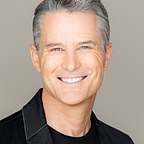Lead With We: Can A Retail Behemoth Become a Key Player in Restoring the Planet?
In its latest TV spot, we follow a bee as it buzzes over a Walmart store and through its thriving garden center. We see solar panels on the roof. The narrator intones, “Everyone deserves to live better. And just being sustainable isn’t enough. Our future depends on regeneration, which is why we’re working to not only protect the planet but restore, renew, and replenish it — so we can all live better tomorrow.”
After 15+ years of corporate sustainability leadership, Walmart last year targeted zero emissions by 2040 — without carbon offsets — and with its foundation committed to protecting, managing, or restoring at least 50 million acres of land and one million square miles of ocean by 2030. In short, it’s undergoing a self-imposed revolution toward regeneration.
“The commitments we’re making today,” said Doug McMillon, President and CEO, “not only aim to decarbonize Walmart’s global operations, they also put us on the path to becoming a regenerative company … and encourages others to do the same.”
It was a bold pledge with enormous ramifications. If the world’s largest retailer could really become a regenerative company across its entire supply chain, the direct impact on the climate emergency would be enormous, with significant knock-on effects by others trying to “compete” with the giant’s efforts. Its regenerative approach to nature “can not only help reverse such negative impacts as the degradation and loss of critical landscapes and the eradication of many species of plants and animals, and sustain key resources for the future,” Retail Leader reported, “but it can also provide about a third of the solution to climate change.”
So, how’s it going so far? Twenty years ago, Walmart struggled to overcome many credible accusations of greenwashing. Activists and others wondered whether a corporation as mammoth as Walmart could “ever be truly ‘green’.”
Today, at least as far as the environment goes, the company is emerging as a Lead With We model, addressing all its systems and processes: energy, waste, packaging, product use and design, and nature protection and restoration.
To achieve its regenerative goals, Walmart is employing a three-pronged strategy:
- Harvesting sufficient wind, solar, and other renewable energy sources to run its facilities with 100 percent renewable energy by 2035.
- Electrifying and zeroing out emissions from its entire vehicle fleet, including long-haul trucks, by 2040.
- Switching to low-impact refrigerants for cooling and electrified equipment for heating in its stores, clubs, and data and distribution centers by 2040.
It has reported significant progress on all those goals already.
For example, on the regenerative agriculture front, the company is partnering with nonprofits such as the Midwest Row Crop Collaborative to build KPI’s and tactics for regional farmers to evolve their practices on the ground, aiming to increase soil health, decrease greenhouse gases, and improve water quality and biodiversity.
And because most emissions in the retail sector derive from product supply chains (as opposed to retail stores and distribution centers), Walmart created Project Gigaton. The initiative aims to avoid one billion metric tons (a gigaton) of greenhouse gases from the global value chain by 2030. How? By engaging suppliers, NGO’s, and consumers in climate action. To date, about 3,100 suppliers have formally signed on, making Project Gigaton one of the largest private sector consortiums for climate action.
What can all industries and businesses learn from Walmart’s regenerative efforts?
- That collectivized purpose is the plot of our shared human story. That we exist to look out for each other. Our very survival depends on it. And because we don’t write our stories on stone anymore, they can change, intentionally. So, it’s time to shift our story from sustainability to regeneration. We should start with business, because business is the epicenter of both the pressing problems and potential solutions , and it’s best positioned to defuse those challenges at scale.
- That regeneration is not only a worthy — but an imperative — endeavor. “Our economic systems, investments, and policies,” argues Paul Hawken in his seminal new book, Regeneration: Ending the Climate Crisis in One Generation, “can bring about the degeneration of the world or its regeneration. We are either stealing the future or healing the future.” Business is the fulcrum of that choice — and it is a choice.
- That SMART goals — specific, measurable, achievable, relevant, and time-limited, publicly shared — is a best practice. You don’t have to be perfect, but you do have to take responsibility.
- That you don’t have to go it alone. There are plenty of collaborations you can join. For example, Regeneration International consists of about 250 global partners — in concert With a wide body of consumer activists — all co-creating a growing number of “regeneration alliances” throughout the world. The group works With multiple stakeholders in key regions (e.g., South Africa, India, Mexico, Guatemala, Belize, Canada, and the US) who are committed to building alternative food and farming systems “for the purpose of restoring climate stability, ending world hunger and rebuilding deteriorated social, ecological and economic systems.”
- That small businesses, too, can and must be part of the movement toward regeneration. It starts with considering a Virtuous Spiral of increasing collaboration with all stakeholders, considering all shareholders in our collective future as equals, all worthy of care — all worthy of life.
To learn more about how you can Lead With We, the Virtuous Spiral of Collectivized Purpose, and the strategies and tactics now being deployed by the world’s smartest and most purposeful brands, visit LeadWithWe.com
